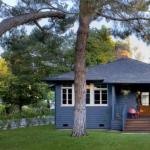Most often, residents of new buildings and panel houses. This is not accidental, because in panel houses, soundproofing at a very low level. Therefore, we decided to collect all the information on this topic and write a detailed article.
Soundproofing in a panel Khrushchev
One of distinguishing features panel Khrushchev remains extremely poor sound insulation. And no matter how much they struggled with this, the sound insulation in panel high-rise buildings leaves much to be desired. And all due to the fact that in Khrushchev they used large-format panels that they tried to make as dense and thin as possible, in addition, it was necessary to achieve weight reduction and thinning of the supporting structures. Plus, holes and crevices are inevitable in large-panel construction. And here you have the problem of poor sound insulation, in all its glory.
In the first Khrushchev type K7, II-35 - the thickness of the floor slabs was 120 mm, and the thickness of the inter-apartment walls did not exceed 10-12 cm. On the contrary, in the II-03 series, the floors had a thickness of 220 mm + 50-100 mm of slag + the floor along the logs on elastic gaskets. That is, while old technologies were used with slabs of 200-220 mm each and backfilled with slag or expanded clay, gypsum screeds, as in modern Khrushchev large blocks and brick buildings, soundproofing was present.
Soundproofing in panel buildings
 Let's first understand how sound insulation in panel houses differs from sound insulation in brick or monolithic houses? You need to know that in monolithic and panel houses, for example, the sound of a perforator will be heard throughout the house, almost as if they are drilling in a neighboring apartment, while in brick houses shock noises spread much worse, however, airborne noises in prefabricated houses do not spread much worse than shock noises, in contrast to monolithic houses. It's all about being fat. monolithic walls preferable to other materials as protection against street noises or, say, from singing in a neighbor's apartment. However, if the tenants of one of the apartments started repairs, life in monolithic house turns into hell, just like in panel houses. On the contrary, walls made of brick or foam concrete transmit sounds to a much lesser extent by design, but they save less from ordinary household noise.
Let's first understand how sound insulation in panel houses differs from sound insulation in brick or monolithic houses? You need to know that in monolithic and panel houses, for example, the sound of a perforator will be heard throughout the house, almost as if they are drilling in a neighboring apartment, while in brick houses shock noises spread much worse, however, airborne noises in prefabricated houses do not spread much worse than shock noises, in contrast to monolithic houses. It's all about being fat. monolithic walls preferable to other materials as protection against street noises or, say, from singing in a neighbor's apartment. However, if the tenants of one of the apartments started repairs, life in monolithic house turns into hell, just like in panel houses. On the contrary, walls made of brick or foam concrete transmit sounds to a much lesser extent by design, but they save less from ordinary household noise.
With panel houses, in general, everything is much more complicated - here you need to look objectively at the manufacturer of the plates, the thickness of the product, design features houses and quality of construction. Therefore, each series and year of construction of panel houses has its own characteristics in sound insulation.
In none of the new prefabricated houses, floors do not meet the standards!
Therefore, soundproofing is done at the very first, rough stage of work!
With regard to sound insulation of residential premises in Russia, very strict standards apply. And they are much tougher than similar norms in the West, especially in Italy or America. But the trouble is that none of the builders of developers even thinks of sticking to them. The main task of builders is to build cheaper and sell more expensive. They also save on soundproofing, because at first glance it is almost impossible for a non-specialist to evaluate it. And if in project documentation enable all necessary measures in terms of sound insulation, this will immediately lead to an increase in the cost of construction by 30-40 percent!
Soundproofing standards in panel houses
The acoustic ecology of a dwelling begins with the knowledge of sound insulation standards, which are described in the set of rules for noise protection SP 51.13330.2011 (updated version of SNiP 2003). Sound insulation of enclosing structures (ceilings, walls, partitions, doors, etc.) is the ability to prevent the spread of sound, reduce the pressure of noise on people in the room. Noises in houses are divided into two types - depending on the characteristics of education. To protect against each of them, the set of rules provides for its own standards and indicators.

Airborne noise!
The so-called airborne noise arises in space and, thanks to sound waves, penetrates through walls, floors, ceilings. This is the sound of musical instruments, TV, player, neighborly conversations and so on. In accordance with the mentioned document, the standard for protection against airborne noise in an economy-class panel house is sound insulation at the level of 50 dB.
Impact noise!
But much more often the residents of the house are worried about the so-called shock noise. It is formed due to mechanical impact on the floor slab in any way - from the steps of people, the movement of furniture, repair work. The transmission of impact noise in the house is determined by a special device that measures the level sound pressure. The higher this figure, the worse the situation with the audibility in the building. In panel houses, the sound pressure level of 60 dB is considered the permissible limit.
The difference between shock and airborne noise!
Impact noise for residents of houses is much worse than air. Firstly, according to the laws of physics, sound waves gradually fade in the air, and therefore, most often, such noise disturbs only immediate neighbors who are unlucky enough to live next to “singers” or “screamers”. Whereas impact noise certain features designs can "please" the whole house. Secondly, in most cases, the level of impact noise is not regulated by law (the ban is imposed only on repair work at an unspecified time). If you can complain to the appropriate authorities about too loud singing or watching militants, then you can’t find a council on a neighbor from above, walking around the apartment in high heels.
Causes of poor sound insulation of panel houses
 The most common reason is the poor quality of work. Enclosing structures must be designed so that during construction and operation, even minimal through cracks and cracks do not occur at their joints. If such nevertheless formed, then, according to the rules, they should be cleared and filled to the full depth with sealant. The seams of internal walls and partitions made of bricks, ceramic and cinder blocks must also be filled and plastered on both sides. However, often in panel houses, these works are done carelessly. But only new settlers who accept apartments without finishing can detect such flaws. But the poor quality of the termination is not the only reason for the violation of sound insulation. It happens that the installation technology of inter-apartment and interior partitions from modern materials, the use of which must strictly follow the manufacturer's instructions. But that's not all. Many panels used for inter-apartment partitions have internal voids. Conducted tests in sound chambers - everything is normal. But during the tests, they do not take into account that sockets will be installed in the walls and hidden wiring will be made. Now imagine that the socket fell on the void - that's it, nothing is left of the soundproofing!
The most common reason is the poor quality of work. Enclosing structures must be designed so that during construction and operation, even minimal through cracks and cracks do not occur at their joints. If such nevertheless formed, then, according to the rules, they should be cleared and filled to the full depth with sealant. The seams of internal walls and partitions made of bricks, ceramic and cinder blocks must also be filled and plastered on both sides. However, often in panel houses, these works are done carelessly. But only new settlers who accept apartments without finishing can detect such flaws. But the poor quality of the termination is not the only reason for the violation of sound insulation. It happens that the installation technology of inter-apartment and interior partitions from modern materials, the use of which must strictly follow the manufacturer's instructions. But that's not all. Many panels used for inter-apartment partitions have internal voids. Conducted tests in sound chambers - everything is normal. But during the tests, they do not take into account that sockets will be installed in the walls and hidden wiring will be made. Now imagine that the socket fell on the void - that's it, nothing is left of the soundproofing!
Soundproofing screeds in a panel house!
Oddly enough, the noise "hell" is often organized by the residents themselves and their neighbors. First of all, those who buy apartments without finishing or make overhaul. Often, when making repairs, apartment owners save centimeters in low dwellings and do not lay a soundproof layer under the floors.

Often, "homemade" violate the technology out of ignorance. “The floor slab in a panel house does not provide the required insulation. For good sound protection, a “floating floor” is required. Such a floor should not have rigid connections with the bearing part of the ceiling, walls and other building structures. Concrete screed must be separated along the contour from the walls and other structures of the building by gaps 1-2 cm wide, filled with soundproofing material, such as SoundGuard soundproofing sealant. Contrary to popular misconception, this is not done for downstairs neighbors. Properly made floating floor - main defense from impact noise! Increased audibility can also be formed in the process of redevelopment of the apartment. Often, property owners move the kitchen, expand the bathroom or toilet. If next to the bedroom of one apartment, as a result of the "creativity" of the residents, there is a bathroom of another apartment and the sound of the drained water prevents the neighbors from sleeping, it is pointless to blame the builders and the quality of the sound insulation in the panel house.
How to make soundproofing in a panel house?
1. Decide for yourself what is more important to you: to lose a few cm in return for comfort or to put up with and endure noisy neighbors? The time and money spent on soundproofing measures will return to you a hundredfold in the form of cheerfulness in a few months, healthy sleep and good mood.
2. Take soundproofing seriously as a separate project. Most of our clients are beginning to understand that it is impossible to live in this nightmare, just by making expensive designer repairs and moving into an apartment. Many of them have been arguing with neighbors for more than one year, they endure, and someone is even forced to sell housing or dismantle everything and make new renovation with effective soundproofing.
3. Soundproofing is done at the very first, rough stage of work.
4. It is necessary to strictly, scrupulously adhere to the technology of work. You can not exclude a single stage, even if it seems insignificant to you.
5. Performing soundproofing work in any case requires certain losses usable area and room height. It is recommended to contact specialists at the design stage. Even if you are not going to order installation from them, you can and should get recommendations on necessary design to minimize these losses and choose the most effective option soundproofing your room.
6. Soundproofing in the room begins with the walls, after the walls they make the ceiling, then the floor.
7. From shock noise (stomp, repair noise, music), metal-frame is the most effective. Frameless soundproofing mainly solves the problem of combating airborne noise, protects from a loud TV behind the wall, a crying child, a barking dog or loud neighbors.
8. Soft and light materials (glass wool, polystyrene, etc.) are not soundproof, despite the fact that some manufacturers write so on their packaging. These are sound absorbers! However, it is part of the structure and performs its function - it removes the rumble ("drum effect") inside the structure and works on sound absorption.
9. THE MAIN RULE IN SOUND INSULATION IS MASS AND MULTILAYER. Therefore, the heavier and more layered the material, the less sound it will let through. For today perfect material for soundproofing it. A square meter weighs almost 20 kg (m2 of drywall, for comparison, is less than 10 kg)
10. The metal parts of the frame MUST NOT touch the walls! All metal parts must be glued with vibration damping tape.
11. Special attention you need to give sockets and switches. For them, you need to use special ones. Such a seemingly trifle can nullify all efforts for soundproofing.
12. Walls, ceiling and floor should have a perimeter gap of less than 5mm.
13. Gaps, seams, joints MUST be filled with soundproof sealant.
14. Use for soundproofing only materials that are safe, environmentally friendly and hypoallergenic! Ideally, materials made from natural materials in which there is no chemistry, resins, glue.



Do-it-yourself soundproofing of an apartment in a panel house! Simple Tips!
 An electrical outlet mounted on an inter-apartment wall is very often one of the most likely routes for noise from neighbors. This is easy to verify by simply putting your ear to it (just try not to get electrocuted). The fact is that in some reinforced concrete wall slabs, even at the production stage, through holes are provided for the installation of electrical accessories. Then builders simply mount sockets in two adjacent apartments, leaving a through channel through which noise can almost freely enter your apartment.
An electrical outlet mounted on an inter-apartment wall is very often one of the most likely routes for noise from neighbors. This is easy to verify by simply putting your ear to it (just try not to get electrocuted). The fact is that in some reinforced concrete wall slabs, even at the production stage, through holes are provided for the installation of electrical accessories. Then builders simply mount sockets in two adjacent apartments, leaving a through channel through which noise can almost freely enter your apartment.
What to do?
Dismantle the electrical outlet and junction box, adhering to the rules for electrical safety. You may be able to see the bottom of the neighbor's outlet box when you do this. Install instead of the old junction box -. Then seal the hole. For this operation, it is recommended to use the services of an electrician. Note: Do not use mounting foam to seal the hole without subsequent plastering. Mounting foam is not a soundproofing material and, moreover, has a high combustibility.
2. Risers of the heating system.
 The risers of heating and water supply pipelines, according to building codes, must be laid through interfloor ceilings using vibration-isolated sleeves. For this, the overlap is embedded metal pipe larger than the riser diameter. The gap between the two pipes must be filled with non-combustible sound-absorbing material and sealed with a non-hardening sealant. In practice, this is often not done. Builders either do not close the gaps in the sleeve mineral wool, or simply do not use sleeves, sealing the riser directly into the ceiling with cement mortar. After many years of operation, gaps necessarily appear between the riser pipe and the floor slab. The sound from the neighbors below and above can easily penetrate into your apartment through cracks and gaps. In some cases, unwanted odors also penetrate through such cracks.
The risers of heating and water supply pipelines, according to building codes, must be laid through interfloor ceilings using vibration-isolated sleeves. For this, the overlap is embedded metal pipe larger than the riser diameter. The gap between the two pipes must be filled with non-combustible sound-absorbing material and sealed with a non-hardening sealant. In practice, this is often not done. Builders either do not close the gaps in the sleeve mineral wool, or simply do not use sleeves, sealing the riser directly into the ceiling with cement mortar. After many years of operation, gaps necessarily appear between the riser pipe and the floor slab. The sound from the neighbors below and above can easily penetrate into your apartment through cracks and gaps. In some cases, unwanted odors also penetrate through such cracks.
What to do?
If the riser is laid through the overlap in the sleeve, it is recommended to seal the gap between the sleeve and the riser with heat-resistant silicone.
If the riser is laid directly through the ceiling, it is necessary to clear around the pipe and remove the damaged layer of cement mortar as far as possible (preventing penetration into the neighboring apartment). Then it is recommended to wrap the base of the pipe with soundproofing material (for example,) and cement the broken area of the floor and / or ceiling. Excess insulating material is cut off and the joint is sealed silicone sealant.
3. Joints between floor slab and wall

In places where the floor overlaps adjoin the walls, very often appear deep cracks. This is due to poor quality construction joints and poor quality leveling floor screed. Cracks and cavities formed over time can serve as a good conductor sound from the neighboring apartment.
What to do?
Remove the skirting boards around the perimeter of the room. If possible, use a chisel and a hammer to make a 30-50 mm wide seam along the walls in the floor to the entire depth of the screed. Fill the seam with fresh cement-sand mortar. After drying cement mixture seal the joint with SoundGuard Seal 310 non-curing silicone sealant.
If the apartment has parquet and partial dismantling screed is not possible, then just carefully fill expansion joint between wall and edge parquet flooring silicone sealant. Then fix the skirting boards in place.
4. Joints between "Wall-ceiling" and "Wall-Wall" slabs

Long-term operation of panel houses, as a rule, leads to the formation of deformation cracks between reinforced concrete slabs of walls and ceilings. These cracks are "life companions" of almost all residents of panel houses. Very often they hide behind wallpaper and do not disturb the appearance of a residential apartment. However, these cracks can serve as a channel for noise from the neighboring apartment.
What to do?
Remove old wallpaper. Expand the joints between the concrete panels. Fill the resulting voids and cavities with gypsum putty or cement mortar. After the putty has dried, coat all wall-to-wall and wall-to-ceiling joints. acrylic sealant SoundGuard Seal 310. After removing excess acrylic sealant, you can paint or paste over the room with new wallpaper.
5. Electrical installation boxes

Mounting boxes for connection electrical cables usually located under the ceiling in the central part of the inter-apartment walls. Often they are hidden under the wallpaper, but they are easy to detect by "tapping". Very often, mounting boxes are installed in through holes in the walls and closed with thin plastic covers.
What to do?
Soundproofing of mounting boxes is recommended to be carried out by analogy with electrical sockets, but always with the involvement of an electrician. It is not recommended to twist electrical cables yourself.
Depends on the kind of noise you want to eliminate. All noise penetrating into the apartment can be divided into 2 types: vibration (shock) and acoustic (air). Vibration noise is sound vibrations that propagate in a solid medium. Many people know from their own experience how good it can be to hear when upstairs neighbors throw heavy objects on the floor, jump rope, stomp or rearrange furniture. And if someone in the entrance wields a jackhammer or puncher, the strongest roar is in all apartments high-rise building. That's all there is shock noise.
The noise level of about 40 decibels will not allow you to have a good rest, and the noise level of more than 85 decibels can lead to mental disorders.
The acoustic form of noise is associated with the propagation of sound vibrations through the air. This type of noise includes loud music and voices in a neighboring apartment or room, the rumble of passing cars, etc. Sources acoustic noise- these are uneven joints between the panels, too thin walls, through holes for sockets, etc.
The only thing that can help eliminate noise in a multi-storey building is soundproofing, which must be carried out comprehensively. Soundproofing is the finishing of walls, ceilings and floors with sound-absorbing materials. In addition, for comprehensive soundproofing, it is necessary that doors and windows absorb noise as much as possible. Most high degree you can achieve sound insulation if you take care of it even at the stage of building construction, since the degree of noise absorption depends on the thickness and type of material from which the walls of the house and its internal floors are made.
Comprehensive soundproofing in the apartment
Well-made floor joints and thick concrete walls provide enough good protection from noise penetration. But, unfortunately, when designing / building standard panel houses, the sound insulation factor is not taken into account. To ensure comprehensive noise protection, first of all, it is necessary to soundproof the ceiling, floor and walls using sound-absorbing materials that can be bought from companies selling building materials.
In addition, you need to pay attention to the following sources of noise penetration:
- mounting boxes and sockets;
- water supply risers and;
- joints between ceiling, walls and floor;
- Entrance doors and windows.
Soundproofing the walls in the apartment
In panel houses, partitions and walls often have a small thickness, and therefore they do not absorb sounds well. To ensure soundproofing of the walls, their thickness is usually increased with the help of drywall. The space between it and the wall is filled with a porous material: foam rubber or mineral wool, which prevents the propagation of acoustic vibrations.
The more layers of sound-absorbing materials used, the higher the efficiency of the soundproofing structure.
First from steel profiles frame is mounted. To eliminate the transmission of vibrations from the floor and walls, in the places where the profiles are attached, it is necessary to make gaskets from an elastic substance - for example, rubber. When the frame is prepared, it is glued to the wall sound-absorbing material completely covering its surface. The thicker the layer of this material, the more effective the sound insulation will become. After that, drywall sheets are screwed to the frame.
Soundproofing the ceiling and floor in the apartment
The soundproofing of the ceiling is very importance, since most often the inconvenience is associated precisely with the noise that the neighbors from above produce. The soundproofing of the ceiling is carried out according to the same principle as the soundproofing of the walls. First, a frame is assembled from the profiles, and one should not forget about rubber gaskets at the points of its attachment.
After that, all of it inner space filled with some kind of sound-absorbing substance: glass mat, foam rubber or special sound-proof slabs of basalt or mineral wool. Such plates, with their small thickness, have an excellent absorbing effect. After installing them, the ceiling height in your apartment will decrease quite a bit.
If there is no intermediate layer between the floor covering and the ceiling, the noise from the apartment below will constantly penetrate into your apartment. At the same time, your neighbors will be able to hear everything that is happening in your house, down to the sound of moving chairs and even footsteps. The issue of soundproofing the floor is solved with the help of a special sound-absorbing material that has a small thickness.
This material consists of special paper, fiberglass, foamed polymer or other synthetic material. During the repair process, depending on the type of sound-absorbing layer material, such material can be placed either directly under the screed or under the laminate. This type soundproofing perfectly dampens vibrations, and also absorbs shock. When laying the soundproofing layer, a waterproofing film is placed on top of it.
Noise isolation of mounting boxes and sockets
IN reinforced concrete slabs panel houses have through holes for the installation of electrical equipment. In such cases, sockets become a conductor of noise between neighboring apartments. To ensure the soundproofing of the socket, it must first be de-energized. Having disassembled the socket, it must be pulled out, and then a washer (gasket) made of dense sound-absorbing material - pressed mineral wool, asbestos cloth or thick cardboard - should be placed in the hole. After that, it should be carefully cemented using gypsum mixture.
Working with sockets requires skills in working with electricity, and therefore it is better to entrust it to professionals.
Mounting boxes are usually located under the ceiling in the middle of the wall. IN individual cases they can be hidden under the wallpaper. The soundproofing of boxes is made according to the same principle as the insulation of sockets. You need to get a plastic plug, then install and cement a washer made of soundproofing material. Before carrying out these works, it is imperative to make sure that there is no voltage in the network.
Soundproofing of central heating risers
According to building codes, risers are laid through the ceilings between floors using special sleeves that prevent the spread of noise. The sleeve is a piece of pipe larger diameter embedded in the ceiling. The gap between the pipe and the sleeve must be filled with mineral wool or other sound-absorbing material.
However, it is not uncommon for builders to cement risers without using a sleeve. Over time, the cement breaks down, while the gap between the wall and the pipe increases, and the sound from the apartment from above penetrates through the cracks. To ensure soundproofing of the riser, it is necessary to remove concrete around the pipe to a depth of less than 10 cm. The freed pipe should be wrapped with mineral wool or fiberglass, and then cemented again. The resulting excess sound-absorbing material is cut off, and the place near the pipe is puttied.
Sound insulation of joints, windows and doors
During operation panel buildings cracks often appear between the floor and walls, as well as along the joints, through which noise from neighboring apartments can penetrate. The causes of these cracks can be different deformation of the building, as well as panels that are poorly fitted to each other. To ensure sound insulation of the joints, it is necessary to expand the cracks with a screwdriver or chisel, carefully clean them, prime them, cover them with putty. When the latter dries, the joint surface must be coated with acrylic sealant.
To fill the gap between the floor and the wall, fill it with silicone sealant, then glue it with special tape and install the baseboard in place.
Doors and windows should protect the apartment from noise from the entrance or from the street. To soundproof windows, it is best to install special soundproof double-glazed windows. They use triple glazing technology to minimize noise penetration into the apartment. The gap between the wall and the double-glazed window is carefully sealed.
The more massive and thicker the door, the less sounds it will let into the apartment. Additionally, the doorway is sealed around the entire perimeter with special rubber gaskets. In this case, a threshold is necessarily made, and the space between the opening and door frame sealed with cement mortar. The door should fit tightly enough to the frame.
To effectively increase the sound insulation in the apartment, remember that the best result is possible with integrated approach. In this case, it is necessary to use only high-quality and proven materials. When the apartment is provided good level soundproofing, then life becomes much more pleasant: an alarm system in the yard and noisy neighbors are no longer a problem!
Unfortunately, modern apartments have a low level of sound insulation. That is why the private life of individuals becomes public. Loud music, quarrels and screams, construction work, even footsteps in the hallway and elevator movements - all these sounds can break into your life and make it impossible to relax and unwind.
You can get rid of this with additional soundproofing of walls. It is worth noting that it has two whole functions: soundproofing and sound-absorbing. The first will help you protect yourself from the outside world and noisy neighbors, and the second will keep everything that happens in your apartment within your apartment, so you can watch movies or football without fear after 11 pm.
You can achieve this effect with various materials. Advances in technology have meant that you no longer have to sacrifice valuable square footage and reduce the size of your apartment to improve soundproofing. And carpets on all the walls are also not needed. So how do you shut yourself off from the noisy world?
Ways to make soundproofing in the apartment
If we are talking about soundproofing, then we must definitely proceed from the purpose of the room. The kitchen, bathroom and even the living room can get by with partial insulation. But the bedroom and the nursery are rooms of increased importance, here you need to achieve complete peace and quiet.
Experts have long noticed that the sound is muffled in multilayer structures. But they have a clear disadvantage - a decrease in the useful area of \u200b\u200bthe room. The thicker the partitions, the less noise penetrates into and out of the room, but also the more space occupied by this structure.
The main ways to achieve silence in the apartment are: the use of drywall, plastering and the use of special soundproof boards. Each of them has its own advantages and disadvantages. It is, of course, up to the landlord to decide. Professionals recommend combining these methods, using them in different rooms depending on the desired level of soundproofing.
Soundproofing with drywall

One of the most popular and quite simple ways- soundproofing with plasterboard. He, of course, is not an insulating material. That is why you will need fiberglass or mineral wool. When choosing a material, give preference to soft and semi-soft options, as they have a higher level of sound absorption.
First you need to carefully inspect the walls for damage. All cracks, chips and discrepancies must be carefully sealed. You can use special sealants, or you can get by with ordinary cement mortar.
After that, you can build a frame for the future drywall wall. Experts recommend using a metal profile with a vibration-proof lining, but you can make a frame from ordinary wooden beams. Do not forget to step back 1.5-2 centimeters from the wall itself to create an air cushion, which will also have a positive effect on the level of sound insulation. After mounting the frame, proceed with laying the special insulating material. Make sure that the thickness of this inner layer leaves enough space for the air cushion.

Your "filling" is ready, it only needs to be hidden behind a layer of drywall. Sheets are screwed to the frame with self-tapping screws. The joints between drywall sheets must be sealed with a special mesh and plastered. After that, the wall is ready for painting or wallpapering.
This method has one important drawback - installing drywall takes at least eight centimeters of area on each side.
Soundproofing with soundproof boards

Modern Construction Materials allow you to significantly reduce the amount of work to achieve maximum results. Do not stand still and technology in the field of sound absorption. Special plates, which can be purchased from specialized stores, guarantee high level soundproofing with minimum effort.
The advantages of this material include its lightness, compactness and ease of use. With the help of such panels, even one person who is not a professional builder can make soundproofing in an apartment. The boards can be cut to fit the room, which also facilitates installation.
Another "plus" is additional thermal insulation. Since this material consists of wood chip or stone wool, then the fibers also trap heat inside the apartment, which is especially important for houses with low thermal insulation.
The plates are attached to the wall directly, without any additional frames. Special dowels guarantee the strength of the structure. The joints between the panels are covered with putty, which helps to create a perfectly smooth wall. Prices for Isoplat panels in this moment much lower than they used to be as this technology becomes more and more popular.
Soundproofing with plaster
This method cannot be called effective, since the level of sound absorption of this material is much lower than that of all previous ones. However, plaster takes the least usable space and is used not only as a rough preparation of the wall, but also as a finish. In order to achieve the desired effect, you need to apply several layers of this material.
This method is ideal for residents of panel houses, since sounds are carried through chips and cracks, concrete pores. Plaster can completely relieve you of these shortcomings of the apartment. Carefully inspect walls and ceilings for defects. They need to be sealed separately. Professionals recommend giving preference to sealants in case of detection of serious breaks and cracks. After that, a layer of ordinary plaster is applied. It must be even. Let it dry and carefully inspect the wall again. Darkening, cracks and spots should make you suspicious. These places need to be carefully processed. After that, you can use both wallpaper and finishing plaster.

After a hard day at work, you want peace and quiet. But it is not always possible to enjoy the rest - quarrels, screams of children, loud music or repairs from neighbors can become an insurmountable obstacle for this. To get rid of unpleasant sounds, you need to make soundproofing. Modern materials allow you to perform all the work quickly and at no extra cost.

Peculiarities
“My home is my castle,” as the famous proverb says. IN modern world this is not only a fortress, but also a corner of relaxation from everyone, a place where a person can do what he loves in a comfortable environment, get a boost of energy or, conversely, calm down after an active day. Silence, peace, pacification, solitude - this is what a person desires while at home.
But it is far from always possible to isolate oneself from the whole world in one's home. Steps in the entrance or corridor, the noise of the elevator, the conversation of neighbors behind the wall - all these sounds prevent a person from relaxing, resting alone with himself, distracted from everyday worries and troubles, and forget about his problems. The fault is poor sound insulation.

In the apartment, especially if it is located in a new house, everything that happens outside is well heard. If external soundproofing still somehow saves from street noise, then thin walls between apartments make private life a public domain. You can avoid this if you make soundproofing in the apartment. Quality materials presented on modern market, allow you to work in short time and will not require high costs strength and time.
Modern sound insulation performs two functions - it is actually insulating and absorbing. It not only absorbs noise from the outside, but also drowns out the sounds coming from the apartment. This makes it possible to protect your privacy from outside interference and provides protection from the penetration of any extraneous noise.


Multilayer structures are capable of soundproofing an apartment. But they take up a significant part of the area, which in modern apartments, which do not differ in large footage, is unacceptable. Manufacturers are now offering a large number of materials that do not "eat up" the area and provide good sound insulation. Nevertheless, the small thickness of these materials provides excellent protection from noisy neighbors.
You can protect yourself from extraneous sounds with the help of drywall, soundproofing boards or simple plaster. These methods are most actively used in order to soundproof an apartment.



Modern materials
The modern market offers a wide variety of soundproofing materials. They differ in their composition, structure, cost, efficiency. But most often, soundproofing in apartments is carried out using the following materials, which have proven themselves well:
- decorative blocks;
- basalt cardboard;
- cork coverings;
- mounting foam.



In addition, you can use sound-vibrating sealants, noise-absorbing mastics, special noise-insulating wallpaper or wood-fiber boards. The most profitable in terms of cost savings will be the purchase of rolled sound insulation, which is simply glued to the wall with glue for vinyl wallpaper. Despite all the benefits and ease of installation, this method is more suitable for rental housing, in which you do not want to invest a lot of money.
Roll insulation absorbs sound only by 60 percent, which is considered a rather low figure.


As for drywall, its installation requires additional costs, such as:
- purchase and installation of a metal profile or wooden bars for the frame;
- purchase of fiberglass or mineral wool;
- purchase of vibration isolating material.
Using drywall is a great way to get rid of what's called acoustic noise (the kind that travels through the air). It penetrates through small cracks, chips on the walls, pores of the material from which the wall is built. So an additional wall covering with vibration-proofing material and drywall will significantly reduce the noise level in the room. And the cost of this material is acceptable, because it is about 90 rubles per square meter.
The price range for noise-absorbing materials is much wider - from 60 to 400 rubles per square meter. This range of prices allows you to choose the most suitable option, for example, you can use ordinary felt as a sound-absorbing material.


For all its advantages, drywall structures have a significant drawback - they reduce the area by about 8 centimeters, so it is not advisable to mount them in small rooms. You can use special soundproof panels. They are more expensive than drywall, because they cost an average of 750 rubles per square meter, but they have a ready-made decorative finish made of paper or fabric, and they can also provide good sound insulation with minimal effort.
Decorated slabs can significantly reduce the cost of finishing, if not completely get rid of them.

There are three main groups of soundproofing materials on the modern market, such as:
- hard have in their composition pumice, expanded clay, cork or other porous material;
- semi-rigid are made from materials based on polystyrene foam;
- soft materials are represented by mineral wool, fiberglass and others.


Each of these materials has its own advantages. Of course, the main selection criterion is the level of sound insulation that each material can provide. Of no small importance is the speed of installation, the complexity of the work, the ability to perform the installation yourself, the cost of the material and how much the area of \u200b\u200bthe room will be reduced when using it. Roll materials have the lowest level of noise absorption. The noise level is only 60 percent. But this is a pretty good indicator, especially when it comes to rental housing.
Drywall and soundproofing panels provide about the same result. If there is a difference, then it is insignificant. But the panels take less space, require less effort during installation, make it possible to save on exterior finish. However, their cost is significantly different from the cost of soundproofing materials using drywall.


Device
Soundproofing with drywall in its design resembles a layer cake, which includes the following layers:
- cement mortar or a special sealant designed to level the surface of the wall;
- vibration-insulating material that will help reduce vibrations, which will also have a positive effect on increasing the level of sound insulation;
- frame, which can be metal or wood.
Vibration isolation material is needed in order to get rid of vibrational sound vibrations, namely those that propagate in a solid medium. Everyone is familiar with the noise of a drill, a jackhammer and similar tools. These sounds are referred to as vibrational noises. They spread through the walls of the building, which begin to vibrate quite noticeably. Further, the actual insulating material is used - it can be mineral wool, fiberglass or even felt. And finally upper layer"Pie" is directly drywall. The thickness of this design can reach 8 centimeters.


Soundproof panels often look like ordinary decorative panels, but still have some differences. In particular, this is their composition, which includes basalt or glass fibers. Cellulosic fibers can also be used. Such plates resemble corrugated cardboard, the void inside of which is filled with mineral granules, the base is purified quartz sand.
Improve soundproofing properties panels can be created by creating a multilayer structure. Simple mineral wool or also fiberglass, laid between the panel and the wall, allows you to increase the level of sound insulation several times.


The composition of the plaster used for soundproofing is no different from the usual one. This is the same decorative plaster that is used in the repair or decoration of premises. Of course, she will not be able to significantly reduce the noise level in the apartment, but still the result will be. The fact is that noise penetrates into the apartment through minor damage to the surface of the walls - chips, cracks, loose fitting materials. The plaster levels the walls, fills in the damage, and therefore prevents the penetration of noise.

Mounting technology
You can install soundproofing with your own hands. This is an easy procedure. If everything is done correctly, carefully, then there will be no problems. If questions still arise, then they will be able to answer step-by-step instruction below.
- Installation of sound insulation begins with the alignment of the walls. They need to be carefully inspected and cover up any, even the most minor, damage - cracks, chips and others.
- The next step is the construction of the frame. It can be made of a metal profile with a gasket made of vibration-isolating material or from ordinary wooden bars. The profile can be pasted over with polystyrene tape, which will additionally absorb noise. Suitable as a frame for mineral wool, fiberglass or felt simple grid netting.


- Once the frame is erected, you can start laying the soundproofing material. There should be a free space of about 1.5–2 centimeters between the soundproofing gasket and the wall, the so-called air cushion. She will provide additional protection from noise.
- Drywall is being installed, which is attached to the frame with dowels. decorative trim applied as needed. This can be painting, whitewashing, plastering or varnishing, wallpapering and more.


- Soundproof boards require less effort and time. They are mounted and connected to each other by the "groove-thorn" method. If the walls are uneven, you will need to install a crate. This is the only addition that is required when installing soundproofing boards.


In order for the sound insulation to be as complete as possible, it is necessary to insulate not only the walls, but also the floor, ceiling, sockets, engineering equipment(all kinds of pipes) and windows. The ceiling is insulated in the same way as the walls. As for the floor, a sound-absorbing coating is used for it. Its composition includes special paper, fiberglass, polymer foam or other synthetic material. You can lay the material under the screed or laminate.
To soundproof sockets, they must first be disassembled and removed from the socket, having previously de-energized. A washer made of foam rubber, fiberglass or foam is laid in the nest. The cracks are covered with plaster.



Modern plastic windows provide good protection against extraneous noise, and external sound insulation, even in new houses, is performed quite well. But, nevertheless, installing additional insulation does not hurt. Street noise, especially in major cities, is able to break through any insulation installed by the developer and spoil the rest. Therefore, the soundproofing of windows and external walls must be carried out with particular care.
The installation scheme for soundproofing materials is not as complicated as it might seem at first glance. If you strictly follow the plan, the work will not take much time and effort, and the right material will not “eat up” most of the area.


All work on soundproofing an apartment can be easily done by yourself. The main thing is not to rush, to gradually carry out the installation and installation of materials, carefully coat all the cracks and discrepancies so that the repair gives the expected result - silence. It's not like that complicated operation as it may seem. And when right choice material, it does not take much time. The installation of the same slabs, for example, will take a minimum amount of time, even if all the work is done by one person.

Modern materials can significantly increase the level of sound insulation in the apartment. Drywall is a budget option which is able to provide good sound insulation. When using it, the area of \u200b\u200bthe room, of course, decreases, but not by much. Cheap soundproofing with roll materials. They are easy to install, do not reduce the area of the room, do not require a lot of time.
Of course, you can use the old methods of noise reduction. Carpets on the walls, shelves with books can also increase sound insulation. But the first of these methods is not environmentally friendly, because a large amount of dust accumulates in the carpets and bacteria can multiply, and the second requires a fairly large area. In small modern apartments, a floor-to-ceiling bookcase will occupy a significant part of the room, leaving no room not only for any other furniture, but also for comfortable movement.
Thin modern materials satisfy all necessary requirements providing good insulation without taking up much space.


The decorative component depends on the chosen material. If drywall requires additional finishing, for example, painting, wallpapering, then soundproof panels do not need it. They are good on their own. decorative element, thanks to the decor of fabric or paper, which is applied to them during production.
Instead of mineral wool or glass wool, you can use ordinary foam. It has good soundproofing properties.


A chain-link mesh or its substitute with cells of the same size can be used as a frame. They are attached to the wall as follows:
- first you need to drill holes in a checkerboard pattern at a distance of 1 m from one another;
- plastic or wooden plugs are hammered into them;
- they mount the structure in the form of a puff cake: first, mineral wool (glass wool, polystyrene), then a mesh, which is attached to the corks with nails or screws. The mesh must be well stretched so that it does not sag;
- the wall is covered with a layer of plaster. The solution for it is kneaded from cement and sand sifted through a fine mesh. The proportions depend on the brand of cement. The higher it is, the more sand you need to take. For example, 2–3 parts of sand are taken for one part of M200 cement, and 1 part of cement and 4–5 parts of sand for M300–M400.
Plastering work is best done in warm time to avoid cracking and peeling of the coating.


Very good sound insulation between apartments and interior walls obtained by using gypsum boards. To do this, two plates are installed on the cement mortar parallel to each other, and a void of about 5 centimeters is left between them. Wood is also a good sound insulator. Besides, wooden structures natural, environmentally friendly, they do not emit indoors harmful substances. You can take a bar or boards with a thickness of 50-60 millimeters. They are attached to the walls in the same way as polystyrene and mineral wool, that is, holes are drilled, then corks are driven into the holes, to which vertical slats 50–60 mm thick are attached, and boards are fixed to the slats with nails in a horizontal position.
As sound insulation and insulation, wood-shaving or cement particle boards. They can be plastered, painted, wallpapered or decorated in any other suitable way.
Plaster, which is also sometimes used as a soundproofing material, depending on its variety, may or may not need decorative design.
If you use a special decorative plaster, That additional finishing not required. Ordinary plaster does not always look aesthetically pleasing enough to leave it in its original form, without decorating or painting.


If you isolate the floor, ceiling, windows, sockets, all pipes, only then will the desired silence come in the apartment, which will not be disturbed by any extraneous noise. Soundproofing an apartment is a fairly simple matter if you approach it thoughtfully. The main thing is not to make mistakes that can nullify all efforts. Such errors include the following:
Tired of being aware of the events taking place at the neighbors on the floor? Perhaps you yourself like to invite guests noisy company, or listen good music, which, using headphones, cannot be appreciated. Conflicts over noise between neighbors in modern apartment buildings occur frequently. And this is due to the lack of good sound insulation of the walls. Fortunately, this lack of an apartment can be eliminated on its own.
Important point
It should be noted that sound insulation should perform two functions:
- Soundproofing. The sounds coming from the neighbors will be reflected, you will not hear what is happening behind the wall.
- Sound absorption. Sound waves propagating in your apartment will be absorbed by the sound insulation, the neighbors will not hear the noise coming from you.

Any of the three methods below will help you ensure soundproofing of the walls.
Ways to get rid of noise and order of work
We build a structure from drywall
What will be required
For this you need: drywall profile or wooden slats, hardware suitable for attaching the selected profile to the floor, ceiling and walls, sound-absorbing material, drywall and self-tapping screws for it.
Work order
- Before proceeding to the construction of a soundproof wall, it is necessary to eliminate all cracks and holes in it. Simply cover with cement mortar.
- Then we make a frame for future sound insulation. You should not fasten the profile directly to the wall itself, step back from it 2 centimeters. Under the profile, it is desirable to enclose a vibration-isolating material made of cork or rubber. After the frame is built, we put sound-absorbing material into it. It can be soft acoustic rock wool, glass wool, or semi-rigid slabs from these materials. When choosing a sound-absorbing material, pay attention to the sound absorption coefficient - y soft materials it is usually higher, and, therefore, sound insulation will be more effective.
- The next step is to fasten the drywall to the profile using self-tapping screws. Drywall is an excellent soundproofing material.
- Well, then everything is simple: glue the joints drywall sheets with a special mesh, putty drywall, glue wallpaper or paint the resulting wall.
Price
What will this pleasure cost? We consider approximately: drywall - 90 rubles per m2, sound-absorbing material - from 60 to 400 rubles per m2. These are the main costs, to which we add the cost of the profile and self-tapping screws.
The disadvantages of this method include the “dustiness” of the work, as well as the fact that each such wall will reduce the room by about 8 cm.
We buy ready-made decorative panels
There are several manufacturers of this type of panels on the market now. In the event that the wall is not perfectly flat, such panels will need a crate, to which they are attached to liquid nails and connected to each other using the tongue and groove method. This way to soundproof a room is quite simple, and the result is beautiful, since the panels have a ready-made decorative paper or fabric finish.
Issue price
The cost of panels is on average 750 rubles per m². The soundproofing properties of such panels will be comparable to the properties of materials from the first method. Among the advantages of mounting decorative panels, one should note their ease - one panel weighs about 4 kg.
This method should be used if you plan to insulate the entire room, and not just one wall. Decorative panels in this case, they will decorate the entire interior, and the area of \u200b\u200bthe room will decrease minimally.

We glue soundproofing on the wall: easier than ever and cheaper than cheap
The easiest and least expensive way is to buy rolled sound insulation, which you just need to glue to the wall with vinyl wallpaper glue. For example, insulating substrate"Polyfom" will cost 1310 rubles per roll, while covering 7 m² of wall. Obviously, the option is the most budgetary, but also the least efficient - it will reduce the noise level by only 60%.
It is worth gluing such insulation if you rent a house and do not want to invest money in its repair.
Which way to choose? Decide for yourself, based on the calculation of your strengths and financial capabilities. Let the work done bring the expected result!
Video: an example of soundproofing walls in an apartment
(1
ratings, average: 2,00
out of 5)
Discussion:
Uralets said:
I read the comments ... People have a strange vision of silence. I wandered here to catch the zen from true silence. And everyone has a problem only with the music of the neighbors.
At the right time, but loudly, and even more so at indecent times and loudly - it is decided for 200 rubles. You go to a hardware store - you buy a wrench (larger), come back, knock (on your neighbors) - and with all your foolishness hit them in the knee (them, him, her - who will open it). Mute mode is guaranteed.
Alexander said:
We have such a thing. On our side, the walls are insulated with 36 mm thick foam plastic, and the neighbors have drywall on the walls where there is a void between the wall and the drywall itself, they didn’t even lay mineral wool. T. K. Their Builders told them, they say, it is not necessary, and so the walls are thick. And the walls are made of cinder block and concrete in places. While the neighbors themselves lived, everything was fine, and now they have rented out housing and this has begun ...... Everything is heard. A lonely, loving lady settled there ... .., tell me, if the neighbors at least lay a mineral wool between a sheet of drywall and a wall, given our warm wall will this help us?
Aldos said:
Lyuda, mineral wool is not very useful thing. Google it, you will find a lot of information about it. Some sources claim that mineral wool is a carcinogen!!! Better try foamed polyurethane, it seems to be more neutral.
Luda said:
We made soundproofing with mineral wool, but the sound from the neighbors decreased, but did not disappear, but it appeared new problem dry air. Now we don’t sleep in the bedroom, but we cough, can someone tell me what to do?
Vlad said:
A video about egg containers, not so stupid. As it may seem. I have experience with soviet neighbors who don't suck in heavy metal. For cardboard, especially uneven surface, the best sound absorption coefficient. Bonus: the best absorbent floor (for downstairs neighbors) 5 - 10 cm layer broken glass(bottle) pressed with boards on screws
I can only speak based on personal experience. My neighbors are avid “music lovers” and for a very long time they tortured me with specific music at different times of the day, often in the evenings. No complaints and exhortations helped, and there was no way to change the apartment, and the apartment itself is good. So I decided to repair and soundproofing. Let me just say that it helped a lot. Now I can calmly be in my apartment without any deliveries from the neighbors. but keep in mind that wall insulation takes up some of the footage: frame + material. I have a couple square meters ate. If the size of the room is large or medium - it's not scary, but if the apartment is small, then this is already problematic.
Antic said:
Mira, you need not worry. Any soundproofing will be useful for both you and your neighbors. And it will work equally in both directions. Of course there are certain nuances. For example, the noise of a perforator is almost impossible to reduce, because its impacts are transmitted by vibration.
mirabis said:
Finally found good advice regarding the soundproofing of the apartment. The issue of relations with neighbors is quite painful, especially because of the noise. However, in this article it remains unclear - who should isolate themselves from whom? It seemed to me that all three councils help neighbors more. That is, if any of the technologies is applied, then the sounds from my apartment will be absorbed. But what to do if it is the neighbors who get the noise? I would also like to know about the percentage of sound absorption from inside and outside the room, where all the above options for wall insulation were used.
By clicking the "Add comment" button, I agree to the site.

















